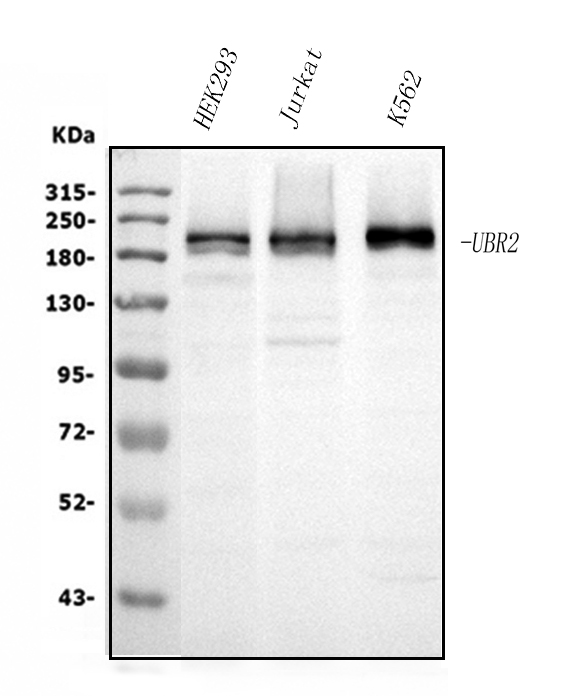Anti-UBR2 Picoband™ Antibody (monoclonal, 2G10)
- SPECIFICATION
- CITATIONS
- PROTOCOLS
- BACKGROUND

Application
| WB |
|---|---|
| Primary Accession | Q8IWV8 |
| Host | Mouse |
| Isotype | Mouse IgG2a |
| Reactivity | Human |
| Clonality | Monoclonal |
| Format | Lyophilized |
| Description | Anti-UBR2 Picoband™ Antibody (monoclonal, 2G10) . Tested in WB applications. This antibody reacts with Human. |
| Reconstitution | Add 0.2ml of distilled water will yield a concentration of 500ug/ml. |
| Gene ID | 23304 |
|---|---|
| Other Names | E3 ubiquitin-protein ligase UBR2, 2.3.2.27, N-recognin-2, RING-type E3 ubiquitin transferase UBR2, Ubiquitin-protein ligase E3-alpha-2, Ubiquitin-protein ligase E3-alpha-II, UBR2, C6orf133, KIAA0349 |
| Calculated MW | 202 kDa |
| Application Details | Western blot, 0.25-0.5 µg/ml, Human |
| Contents | Each vial contains 4mg Trehalose, 0.9mg NaCl and 0.2mg Na2HPO4. |
| Clone Names | Clone: 2G10 |
| Immunogen | E.coli-derived human UBR2 recombinant protein (Position: Q10-A664). |
| Purification | Immunogen affinity purified. |
| Storage | Store at -20˚C for one year from date of receipt. After reconstitution, at 4˚C for one month. It can also be aliquotted and stored frozen at -20˚C for six months. Avoid repeated freeze-thaw cycles. |
| Name | UBR2 |
|---|---|
| Synonyms | C6orf133, KIAA0349 |
| Function | E3 ubiquitin-protein ligase which is a component of the N-end rule pathway (PubMed:15548684, PubMed:20835242, PubMed:28392261). Recognizes and binds to proteins bearing specific N-terminal residues (N-degrons) that are destabilizing according to the N-end rule, leading to their ubiquitination and subsequent degradation (PubMed:20835242, PubMed:28392261). Recognizes both type-1 and type-2 N-degrons, containing positively charged amino acids (Arg, Lys and His) and bulky and hydrophobic amino acids, respectively (PubMed:20835242, PubMed:28392261). Does not ubiquitinate proteins that are acetylated at the N-terminus (PubMed:20835242). In contrast, it strongly binds methylated N-degrons (PubMed:28392261). Plays a critical role in chromatin inactivation and chromosome-wide transcriptional silencing during meiosis via ubiquitination of histone H2A (By similarity). Binds leucine and is a negative regulator of the leucine-mTOR signaling pathway, thereby controlling cell growth (PubMed:20298436). Required for spermatogenesis, promotes, with Tex19.1, SPO11-dependent recombination foci to accumulate and drive robust homologous chromosome synapsis (By similarity). Polyubiquitinates LINE-1 retrotransposon encoded, LIRE1, which induces degradation, inhibiting LINE-1 retrotransposon mobilization (By similarity). Catalyzes ubiquitination and degradation of the N-terminal part of NLRP1 following NLRP1 activation by pathogens and other damage-associated signals: ubiquitination promotes degradation of the N-terminal part and subsequent release of the cleaved C-terminal part of NLRP1, which polymerizes and forms the NLRP1 inflammasome followed by host cell pyroptosis (By similarity). Plays a role in T-cell receptor signaling by inducing 'Lys-63'-linked ubiquitination of lymphocyte cell-specific kinase LCK (PubMed:38225265). This activity is regulated by DUSP22, which induces 'Lys-48'-linked ubiquitination of UBR2, leading to its proteasomal degradation by SCF E3 ubiquitin-protein ligase complex (PubMed:38225265). |
| Cellular Location | Nucleus {ECO:0000250|UniProtKB:Q6WKZ8}. Chromosome {ECO:0000250|UniProtKB:Q6WKZ8}. Note=Associated with chromatin during meiosis. {ECO:0000250|UniProtKB:Q6WKZ8} |
| Tissue Location | Broadly expressed, with highest levels in skeletal muscle, kidney and pancreas. Present in acinar cells of the pancreas (at protein level). |

Thousands of laboratories across the world have published research that depended on the performance of antibodies from Abcepta to advance their research. Check out links to articles that cite our products in major peer-reviewed journals, organized by research category.
info@abcepta.com, and receive a free "I Love Antibodies" mug.
Provided below are standard protocols that you may find useful for product applications.
Background
E3 ubiquitin-protein ligase UBR2 is an enzyme that in humans is encoded by the UBR2 gene. It is mapped to 6p21.1. This gene encodes an E3 ubiquitin ligase of the N-end rule proteolytic pathway that targets proteins with destabilizing N-terminal residues for polyubiquitylation and proteasome-mediated degradation. Alternative splicing results in multiple transcript variants.
If you have used an Abcepta product and would like to share how it has performed, please click on the "Submit Review" button and provide the requested information. Our staff will examine and post your review and contact you if needed.
If you have any additional inquiries please email technical services at tech@abcepta.com.













 Foundational characteristics of cancer include proliferation, angiogenesis, migration, evasion of apoptosis, and cellular immortality. Find key markers for these cellular processes and antibodies to detect them.
Foundational characteristics of cancer include proliferation, angiogenesis, migration, evasion of apoptosis, and cellular immortality. Find key markers for these cellular processes and antibodies to detect them. The SUMOplot™ Analysis Program predicts and scores sumoylation sites in your protein. SUMOylation is a post-translational modification involved in various cellular processes, such as nuclear-cytosolic transport, transcriptional regulation, apoptosis, protein stability, response to stress, and progression through the cell cycle.
The SUMOplot™ Analysis Program predicts and scores sumoylation sites in your protein. SUMOylation is a post-translational modification involved in various cellular processes, such as nuclear-cytosolic transport, transcriptional regulation, apoptosis, protein stability, response to stress, and progression through the cell cycle. The Autophagy Receptor Motif Plotter predicts and scores autophagy receptor binding sites in your protein. Identifying proteins connected to this pathway is critical to understanding the role of autophagy in physiological as well as pathological processes such as development, differentiation, neurodegenerative diseases, stress, infection, and cancer.
The Autophagy Receptor Motif Plotter predicts and scores autophagy receptor binding sites in your protein. Identifying proteins connected to this pathway is critical to understanding the role of autophagy in physiological as well as pathological processes such as development, differentiation, neurodegenerative diseases, stress, infection, and cancer.


